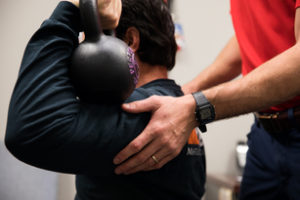Shark week just ended, and it got me thinking about the lessons a shark attack can teach us about pain. Before diving into (nice pun) the lessons to be learned, we need to clarify a few things about pain

There is no such thing as pain fibers
This may come as a shock, but the body doesn’t have pain fibers. Instead of pain fibers, our body has special nerves that gather information, and only sometimes does it result in pain. Activation of these nerves is known as nociception. The translation of nociception is “danger reception.“
The lack of pain fibers and the presence of danger receptors can tell us a little about how humans respond to an event like a shark attack. This in turn could help us learn more about our own aches and pains that happen with everyday life.
What is the purpose of pain?
One of the main functions of pain is safety. Sometimes this works beautifully, like a sprained ankle that is briefly painful to protect the area and limit further damage to the tissues. Other times, it fails miserably like cancer that goes undetected or in chronic pain when there continues to be pain long after the injury has healed. The pain experience is not foolproof.
When your body senses enough danger, pain is likely but not guaranteed.
No doubt coming face to face with a shark is DANGEROUS! But if the goal of pain is to keep us safe, having crippling pain when face to face with a shark is not going to help the goal of survival.
The activation of these danger receptors sets off a cascade of events that are designed to help us reach safety like the sympathetic nervous system which rushes blood to the muscular system to help us swim away and fight.
Pain is more about safety and danger detection than it is about damage.
The next time you get hurt or experience pain, ask yourself “What is this pain trying to tell me?” Perhaps you have struggled with postural pain when you are slumped over your desk at work. That pain serves as a gentle reminder to get up and start moving.
Or the acute lower back pain episode. It may be telling you that you overcooked your leg workout by doing too much, too soon. Try staying active for a few days and decrease the repetitions or sets performed the next time you return to the gym.
Key Points:
No such thing as pain fibers
The pain experience is not foolproof.
Nociception is “danger reception”. It may or may not result in pain
Pain is about safety/danger more than damage.
Learning about pain makes you better equipped to handle it.



